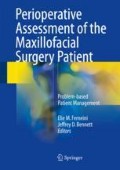Abstract
The reversible and controlled alteration of the mental state by anesthesia is a hallmark of the clinical practice of oral and maxillofacial surgery. Polypharmacy and medical comorbidities can place patients at risk of uncontrolled changes in mental status with consequences. It is incumbent upon the oral and maxillofacial surgeon to be prepared to recognize, understand, and manage a multitude of adverse situations involving unintended alterations in mental status.
Access this chapter
Tax calculation will be finalised at checkout
Purchases are for personal use only
References
Kanich W, Brady WJ, Huff J, et al. Altered mental status: evaluation and etiology in the ED. Am J Emerg Med. 2002;20(7):613–7. https://doi.org/10.1053/ajem.2002.35464.
Odiari EA, Sekhon N, Han JY, David EH. Stabilizing and managing patients with altered mental status and delirium. Emerg Med Clin North Am. 2015;33(4):753–64. https://doi.org/10.1016/j.emc.2015.07.004.
Neufeld KJ, Thomas C. Delirium: definition, epidemiology, and diagnosis. J Clin Neurophysiol. 2013;30(5):438–42. https://doi.org/10.1097/wnp.0b013e3182a73e31.
Ely EW. Delirium as a predictor of mortality in mechanically ventilated patients in the intensive care unit. JAMA. 2004;291(14):1753. https://doi.org/10.1001/jama.291.14.1753.
Thomason JW, Shintani A, Peterson JF, Pun BT, Jackson JC, Ely EW. Intensive care unit delirium is an independent predictor of longer hospital stay: a prospective analysis of 261 non-ventilated patients. Crit Care. 2005;9(4):R375–81. https://doi.org/10.1186/cc3729.
Adlesic EC. Cardiovascular anesthetic complications and treatment in oral surgery. Anesthesia. 2013;25(3):487–506. https://doi.org/10.1016/j.coms.2013.04.002.
Welker KL, Mycyk MB. Pharmacology in the geriatric patient. Emerg Med Clin North Am. 2016;34(3):469–81. https://doi.org/10.1016/j.emc.2016.04.003.
Hamid AA, Ghaleb M, Aljadhey H, Aslanpour Z. A systematic review of hospitalization resulting from medicine-related problems in adult patients. Br J Clin Pharmacol. 2014;78(2):202–17. https://doi.org/10.1111/bcp.12293.
Murdoch D. Mechanisms of status epilepticus: an evidence-based review. Curr Opin Neurol. 2007;20(2):213–6. https://doi.org/10.1097/01.wco.0000263155.48598.41.
Akavipat P, Rungreungvanich M, Lekprasert V, Srisawasdi S. The Thai Anesthesia Incidents Study (THAI Study) of perioperative convulsion. J Med Assoc Thail. 2005;88:S106–12.
Niesen AD, Jacob AK, Aho LE, et al. Perioperative seizures in patients with a history of a seizure disorder. Anesth Analg. 2010;111(3):729–35. https://doi.org/10.1213/ane.0b013e3181e534a4.
Bajwa SJS, Jindal R. Epilepsy and nonepilepsy surgery: recent advancements in anesthesia management. Anesth Essays Res. 2013;7(1):10–7. https://doi.org/10.4103/0259-1162.113978.
Lihua P, Su M, Ke W, Ziemann-Gimmel P. Different regimens of intravenous sedatives or hypnotics for electroconvulsive therapy (ECT) in adult patients with depression. Cochrane Database Syst Rev. 2014. https://doi.org/10.1002/14651858.cd009763.pub2.
Park E, Abraham MK. Altered mental status and endocrine diseases. Emerg Med Clin North Am. 2014;32(2):367–78. https://doi.org/10.1016/j.emc.2013.12.007.
Hamdy O. Hypoglycemia: practice essentials, background, pathophysiology. http://emedicine.medscape.com/article/122122-overview. 2016. Accessed 13 Nov 2016.
Eriksson JW, Bodegard J, Nathanson D, Thuresson M, Nyström T, Norhammar A. Sulphonylurea compared to DPP-4 inhibitors in combination with metformin carries increased risk of severe hypoglycemia, cardiovascular events, and all-cause mortality. Diabetes Res Clin Pract. 2016;117:39–47. https://doi.org/10.1016/j.diabres.2016.04.055.
Gautier J, Monguillon P, Verier-Mine O, et al. Which oral antidiabetic drug to combine with metformin to minimize the risk of hypoglycemia when initiating basal insulin? Diabetes Res Clin Pract. 2016;116:26–8. https://doi.org/10.1016/j.diabres.2016.04.008.
Kirkland L. Adrenal crisis: background, pathophysiology, epidemiology. http://emedicine.medscape.com/article/116716-overview. 2016. Accessed 13 Nov 2016.
Bondugulapati LNR, Rees DA. Inhaled corticosteroids and HPA axis suppression: how important is it and how should it be managed? Clin Endocrinol. 2016;85(2):165–9. https://doi.org/10.1111/cen.13073.
Liu D, Ahmet A, Ward L, et al. A practical guide to the monitoring and management of the complications of systemic corticosteroid therapy. Allergy Asthma Clin Immunol. 2013;9(1):30. https://doi.org/10.1186/1710-1492-9-30.
Raff H, Sharma ST, Nieman LK. Physiological basis for the etiology, diagnosis, and treatment of adrenal disorders: Cushing’s syndrome, adrenal insufficiency, and congenital adrenal hyperplasia. Compr Physiol. 2014;4(2):739–69. https://doi.org/10.1002/cphy.c130035.
Hopkins RL, Leinung MC. Exogenous Cushing’s syndrome and glucocorticoid withdrawal. Endocrinol Metab Clin N Am. 2005;34(2):371–84. https://doi.org/10.1016/j.ecl.2005.01.013.
Dunkley E, Isbister G, Sibbritt D, Dawson A, Whyte I. The hunter serotonin toxicity criteria: simple and accurate diagnostic decision rules for serotonin toxicity. QJM. 2003;96(9):635–42. https://doi.org/10.1093/qjmed/hcg109.
Greenier E, Lukyanova V, Reede L. Serotonin syndrome: fentanyl and selective serotonin reuptake inhibitor interactions. AANA J. 2014;82(5):340–5.
Sansone RA, Sansone LA. Serotonin norepinephrine reuptake inhibitors: a pharmacological comparison. Innov Clin Neurosci. 2014;11(3/4):37–42. http://innovationscns.com/serotonin-norepinephrine-reuptake-inhibitors-a-pharmacological-comparison/. Accessed 13 Nov 2016
Taghavi Zenouz A, Ebrahimi H, Mahdipour M, Pourshahidi S, Amini P, Vatankhah M. The incidence of intravascular needle entrance during inferior alveolar nerve block injection. J Dent Res Dent Clin Dent Prospects. 2008;2(1):38–41. https://doi.org/10.5681/joddd.2008.008.
Heavner J. Cardiac toxicity of local anesthetics in the intact isolated heart model: a review. Reg Anesth Pain Med. 2002;27(6):545–55. https://doi.org/10.1053/rapm.2002.36458.
Ciechanowicz S, Patil V. Lipid emulsion for local anesthetic systemic toxicity. Anesthesiol Res Pract. 2012;2012:131784. https://doi.org/10.1155/2012/131784.
Kapitanyan R. Local anesthetic toxicity: practice essentials, background, pathophysiology. http://emedicine.medscape.com/article/1844551-overview. 2016. Accessed 13 Nov 2016.
Jauch EC. Ischemic stroke: practice essentials, background, anatomy http://emedicine.medscape.com/article/1916852-overview. 2016. Accessed 13 Nov 2016.
Macellari F, Paciaroni M, Agnelli G, Caso V. Perioperative stroke risk in nonvascular surgery. Cerebrovasc Dis. 2012;34(3):175–81. https://doi.org/10.1159/000339982.
American Heart Association and American Stroke Association. http://www.strokeassociation.org/STROKEORG/WarningSigns/Stroke-Warning-Signs-and-Symptoms_UCM_308528_SubHomePage.jsp, http://www.strokeassociation.org/STROKEORG/WarningSigns/Learn-More-Stroke-Warning-Signs-and-Symptoms_UCM_451207_Article.jsp#.Wg43k7bMwUF. Accessed 8 Nov 2016.
Author information
Authors and Affiliations
Corresponding author
Editor information
Editors and Affiliations
Rights and permissions
Copyright information
© 2018 Springer International Publishing AG
About this chapter
Cite this chapter
Badwal, R.S. (2018). Altered Mental Status as a Complication of Maxillofacial Surgery. In: Ferneini, E., Bennett, J. (eds) Perioperative Assessment of the Maxillofacial Surgery Patient. Springer, Cham. https://doi.org/10.1007/978-3-319-58868-1_42
Download citation
DOI: https://doi.org/10.1007/978-3-319-58868-1_42
Published:
Publisher Name: Springer, Cham
Print ISBN: 978-3-319-58867-4
Online ISBN: 978-3-319-58868-1
eBook Packages: MedicineMedicine (R0)

